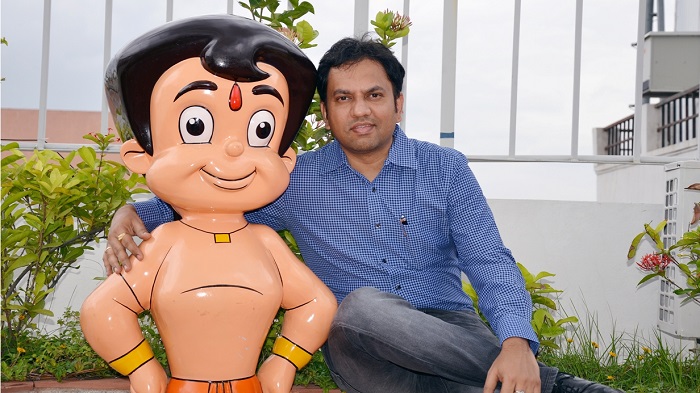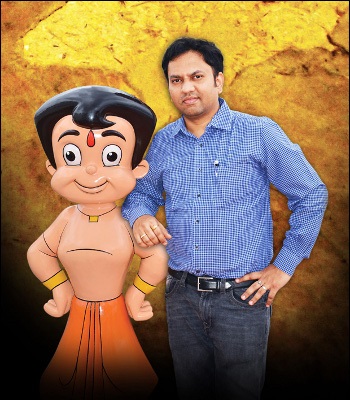Green Gold Animation is all set to start its new Mumbai branch- Golden Robot Animation Studio. We spoke to Green Gold Animation founder and CEO Rajiv Chilaka about the newly opened studio, the studio culture and future plans of expansion and IP creation.
When did you decide to start Golden Robot? How much time did its development take?
We found teams in Mumbai with talented people but for some reasons those studios were not doing well, so these people were not paid well. These teams were available and wanted to do something but were not backed financially. We felt that we already have people working in Hyderabad. And Mumbai was where we wanted to do more things. This team was readily available so we thought we should look at supporting them and bring them under the umbrella of Green Gold. Hence we decided to go ahead with the idea of a studio in Mumbai. It took about six months to get this started.
Did you approach them?
Proposal came from their side. We are giving work to a lot of studios nowadays. These studios vary from being small to large in size. We were also looking to expand our production facilities and want to have a control over the company because then we can decide what projects needs to be done, what to prioritise et cetera.

Why did you name your new studio “Golden Robot Animation Studio”?
The new creative team has come up with the name. They wanted to have some connection with Green Gold, hence “Golden”. People see a robot as somebody who does physical work but actually are machines with advanced technology, and are intelligent and creative. Hence the name “Robot,” and “Golden Robot Animation Studio”.
Tell us about your team. Who are the creative and management heads?
Primarily, there are three members. R. K. Chand is heading the company and looking at the business development. He will be the key guy in building collaborations and partnerships. Ritesh Kumar is the creative head and Abhishek Chandra is the animation head.
From our side (Green Gold Representatives), Srinivas Chilakalpudi will be overseeing the development of the company on day-to-day basis. Sunil and I will be involved in various aspects of development and expansion. My role is to make sure that there is enough work for them to keep it going.
Right now we are about 90 people and are planning to take it to 180. That is the first step. There is plenty of manpower available in Mumbai and some really quality and senior men in Mumbai.
Initially, we wanted to make it a feature film development studio but we scrapped that because we are building the team. So, once we get to the larger side, in the future we may plan just to do feature films.
Tell us about the facilities in your animation studio, the technology that is going to be used and the infrastructure.
We’ve built a brand new 180-seater studio which is located in DLH building, Goregaon. We are buying latest computers and software. We will be using Maya as our primary software and a combination of numerous software. Both in terms of hardware and software, we are using the latest.
Infrastructure-wise, we are a world-class studio. There are few mechanisms and pipeline that we are building which will help build some of the tools in-house. Building hardware and software tools will take a few months but we have a prototype ready. This will help in not only production management but also in improving the quality of shows.
What is the office culture?
People work with high energy. A lot of them have been suffering as there wasn’t proper source of income. But now suddenly they are getting a stable source of income and are able to focus on their work. A basic thing that an artist needs is stability. People in animation have been suffering as the industry as it is had a tough time but the next decade will be really good as the content demand is growing. Also, I think the next big market will be Asia as it has six hundred million kids and will have much more potential than Europe or the US.
Business-wise, how do plan to expand the company?
One of the challenges since the last 18 months is that there is so much work coming to the Indian market due to a lot of reasons. Firstly, the quality of Indian shows has improved drastically and it is attracting people from everywhere. Secondly, cost-wise it is not cheap anymore in India but is cheaper than let’s say a European nation or an American nation. There are other countries that can produce at a cheaper price than India. But what comes with quality and value for money, I think India is the best place in the world.
Going back to the kind of activities that are happening in the India market, there are over 25 kids channels and about ten of them are producing content for Indian market. VOD platforms such as Amazon, Netflix, Hotstar and Voot are also producing animated content. That again increases the work. You can actually count on your fingertips how many studios have successfully animated content. This gives scope for another five or six players to enter the market and work together. Hence we felt this would be a good time to start the studio that will independently run by itself, and financially back it up. Green Gold already has 600 people but will probably expand by another two thousand in the next one year. But we don’t want to continually increase our man power. Hence, in the next few months, we will be looking forward to invest in other studios or finding people who need support. If the industry grows, everybody benefits, directly or indirectly.
Any plans to extend to other cities?
Right now, we have no plans to go to other cities as we are only looking to tap the talent in Mumbai.
How do you stay in touch with your Mumbai team?
I come to Mumbai every other week and we have calls on day-to-day basis. Initially, there will be more efforts needed from our team but once we set the ball rolling, there is no need to look into it on day-to-day basis as we already have an experienced team. After some initial guidance, we’re set.
Do you plan to create a new IP and name it Golden Robot?
That is a good question. Actually we had something like that in mind but we have to develop a proper story. Current focus is team-building and getting the right people to head right departments. First step is to build a quality team that can deliver certain amount of work in a month. Second step would be to do a co-production. Third step would be to create your own IP.
Any studios you are in touch with for co-production?
We are talking to few international studios but it is at very initial stages as we just started on 1 August. We plan to primarily look for partnerships and find good co-production projects for Golden Robot at MIPCOM.
Can you give an idea on what kind of feature you plan to do?
The first step would be to do some Indian localised feature film (animation and CGI). We’d look at working on domestic production, then slowly build it up in three to four years to a stage that we are ready to do Hollywood feature films. So that is basically the goal.
Quality-wise we are going to step it up. First step would be TV, second step would be film, third step would be international feature film.
Any major broadcasters and OTT platforms that you’re planning to collaborate with?
As of now, we’re looking at domestic players such as Amazon, Voot, Hotstar. We will also be looking at local TV stations such as Disney, Cartoon Network, Nickelodeon, Sony, and Discovery Kids.
Are any new series of Chhota Bheem coming up?
We are currently working on Super Bheem. It is being done in 3D CGI. After doing 279 episodes of Chhota Bheem, we decided to give it a break as it was getting monotonous. When we do, we will re-launch in a bigger way. In the meantime, we felt we can have an adventure in space, fantasy series called Super Bheem.
Soon, we will be coming up with a Chhota Bheem feature film Kung-Fu Dhamaka that has been in the pipeline for some time now. But we will release it in 2018.
Recently Nazara Games launched a new game series of Chhota Bheem. Can you tell us more about that?
Nazara Games has been around for three years now. It has been a great partner to us and will also work with us for a few more IPs that will come up soon.
Now that Golden Robot is in Mumbai, will it bring a challenge to others players?
There are very good studios in Mumbai currently. Whoever can do more, can take more work. But we’ve never been in the rat race. Our goal will always be quality over quantity and focus on the next project that comes.
Do you think more animation studios will open in Mumbai after Golden Robot?
It will happen. But animation is a tricky business. You need to have deeper understanding of it. The team building takes approximately three to five years. But challenges aside, studios have a lot of potential to grow from small to large.
